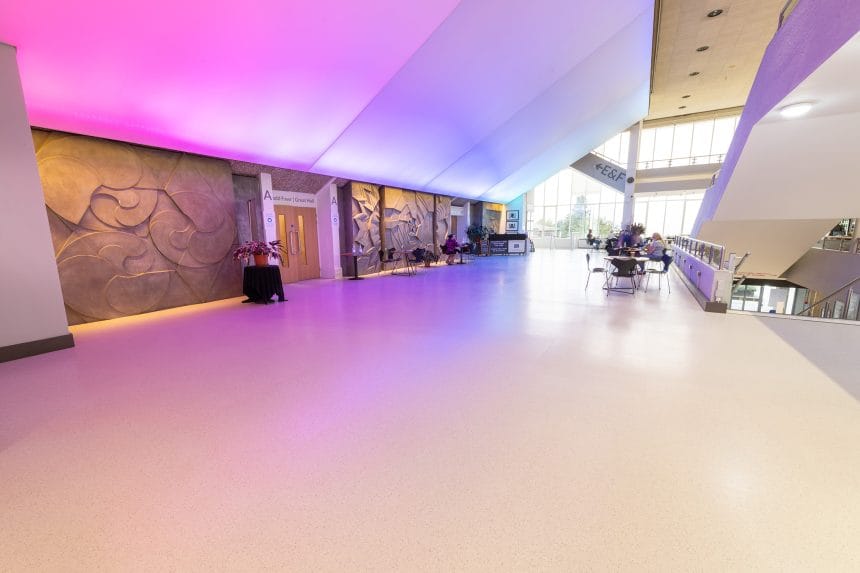Aberystwyth University
F. Ball Raises the Level at Aberystwyth University



Technical representatives from F. Ball and Co. Ltd. have provided flooring contractors, with a cost-effective alternative to completely removing and replacing a weakened screed as part of a flooring refurbishment at the Aberystwyth Arts Centre, part of Aberystwyth University.
The Brief
The company was contracted to install rubber flooring over two floors of the university arts centre’s main building, a total area of approximately 300m2. The building was constructed in 1970 and was extended in 2000. It was also subject to flooding in 2020. Both the ground floor and first floor had concrete substrates, and the first floor also had a small section of raised access timber flooring.
How were the products used, and why?
Upon removing old floor coverings, flooring contractors were faced with an extremely rough screed with weak patches, possibly the result of poor installation or curing techniques, environmental factors or age, that was unsuitable for the application of subfloor preparation products and the installation of floorcoverings. Some weak sections were mechanically removed, leaving about 75mm thickness to be made up. A structural engineer confirmed that the concrete bases were, otherwise, structurally sound. New P5 chipboard was affixed to the wood subfloors with screws and glued at the joins.
It is often necessary to completely remove and replace a weakened screed. However, F. Ball technical representatives called upon to conduct a site assessment were able to recommend a less costly and time-consuming solution to make the surface suitable to receive floorcoverings, including quickly raising the level of floors where sections had been mechanically prepared.
Firstly, any remaining weak spots in the base would need to be removed by mechanical means along with any surface contaminants to create a clean, sound micro-textured finish. Any dust and debris should also be swept away.
Moisture tests indicated subfloor relative humidity (RH) levels in the concrete subfloors were as high as 78%, meaning a moisture management solution would be required to prevent excess subfloor moisture attacking floor coverings and adhesives, potentially causing complete floor failure. Contractors therefore applied a single coat of Stopgap F77 solvent-free epoxy waterproof surface membrane over the entire area to obtain a continuous barrier against subfloor moisture.
Flooring contractors then used Stopgap 600 deep section smoothing compound to raise the level of floors where weak patches of screed had been removed. Most smoothing compounds can be applied up to a maximum thickness of 20mm, whereas Stopgap 600 can be applied at a thickness between 5–50mm, meaning only two applications would be required to achieve the required 75mm thickness. The product can also be pump applied, as the contractors opted to do, saving further time.
It was also recommended that the chipboard over the raised access floors was checked to ensure that the surface was clean, secure and undamaged before applying a minimum thickness of 0.2mm of Stopgap Fill and Prime over the entire area. Stopgap Fill and Prime is a flexible cement-based primer, which has a thixotropic consistency, meaning it flows freely when stirred but sets to a gel-like consistency on standing, enabling it to fill joints between panels, preventing indentions that could transfer to the finished installation when a smoothing compound is applied.
The whole subfloor area was then capped with a layer of Stopgap 1200 high performance smoothing compound to create a perfectly smooth base for the receipt of new floor coverings.
The final phase of the refurbishment was to install Nora rubber sheet floor coverings using Styccobond F48 PLUS in accordance with F. Ball’s Recommended Adhesives Guide (RAG®). The adhesive develops the high bond strength required to hold flooring in place when exposed to high temperatures, which are expected in heavily glazed areas of the university building. It is also fibre-reinforced to provide high initial grab to prevent floor coverings moving when working.